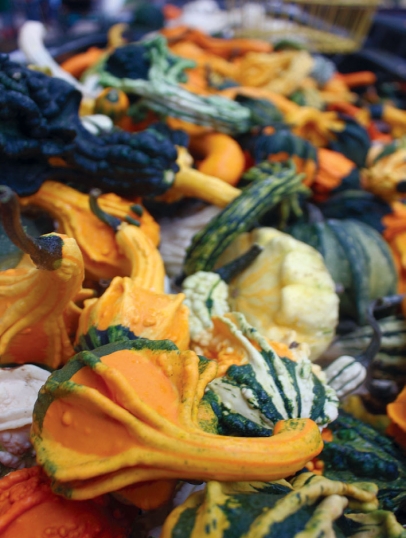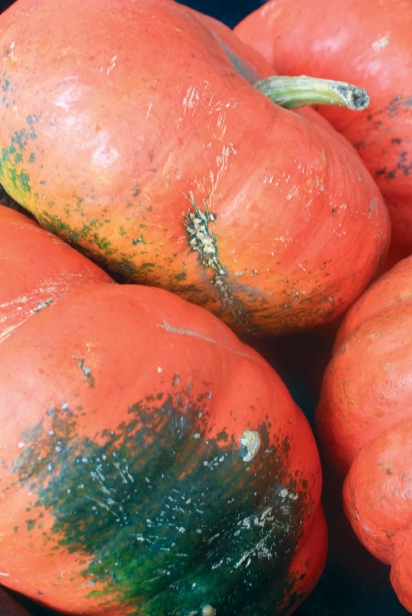Pierce's Pumpkin Patch
Let’s begin with some numbers. Thirty acres. Over seventy varieties of pumpkin, squash and gourds are grown at Pierce’s Pumpkin Patch near Columbia in rural Marion County. Five seeds are planted per hill, and approximately 5,000 hills are planted. All by hand. Let me repeat that. All by hand. That makes 25,000 individually hand planted seeds. John and Joy Pierce own and run the operation and have since 1981. During planting they have the help of one or two more people, and the planting is done over a few days, depending upon the weather.
When they are not planting, tending, harvesting and selling pumpkins, squash and gourds, John and Joy are first responders, and when a call goes out for a medical incident in the southwestern part of Marion County or northern Lucas County, John is probably driving the ambulance while Joy tends to the patient. Joy also works in the Emergency Room at the Knoxville Hospital. At a fire scene, John will have incident command as Fire Chief. Three of their sons also are on the department, and when an emergency calls the family away from the farm, other family members step in to help visitors to the Pumpkin Patch. John is also a historian. I don’t think anyone knows more about this part of the world than John, and his local newspaper collection rivals local libraries.
Pumpkins, gourds and squash are all members of the Cucurbitacea family, which hosts more than 100 genera and over 700 species. And they are fruits, not vegetables, being that they are seed bearing structures that develop from the ovary of a flowering plant. They are native to the Americas, and likely originated in and spread north from South and Central America. Cultivation began as early as ten thousand years ago and varieties spread northward at varying paces. Domesticated Cucurbita pepo seeds are regularly found in archaeological sites throughout southern North America as early as 4,000 years ago. Native Americans were very likely growing squash on the Pierce’s property thousands of years before Europeans arrived.
Five genera have been domesticated, including hundreds of species. Despite their different names, pumpkins, gourds, and squash can all be considered squash--pumpkin referring to the large orange variety with all of cultural meaning around Halloween we are familiar with. Gourds are simply squash with hard skins and without much consumable flesh. In general, squash are categorized as summer or winter. Summer squash, like zucchini and yellow squash are eaten when young, when the skin is soft and before the seeds harden. It needs to be eaten fresh, canned or frozen, Winter squash is mature fruit, with hard seeds and skin, and preserves very well on its own in a cool, dark place.
The Pierce farm focuses on winter squash and the harder skinned varieties. Pumpkins, acorns, spaghetti, butternut, scallops, and pink banana are some of the more popular varieties. John tells me that delicata, with its longitudinal dark green stripes with a yellow or cream colored background, is gaining in popularity. Part of the appeal of Pierce’s Pumpkin Patch is the great variety and abundance of the squash. Anyone can grow a zucchini, not everyone can grow so many varieties of pumpkins, squash and gourds and pile them high. They grow them big too--a 375 pound pumpkin topped the charts a few years ago.
colored background, is gaining in popularity. Part of the appeal of Pierce’s Pumpkin Patch is the great variety and abundance of the squash. Anyone can grow a zucchini, not everyone can grow so many varieties of pumpkins, squash and gourds and pile them high. They grow them big too--a 375 pound pumpkin topped the charts a few years ago.
While large pumpkins have a certain “ooh-ah” appeal, there isn’t much market for a pumpkin too big to carry. Josh Stansbery, who increasingly plays a more significant role helping John and Joy, says “State Fair record setting pumpkins take a lot of work--and we prefer to plant, hoe and go.”
People come in droves from September through mid November. The big event of the year is the Annual Pumpkin Festival in October. This year mark your calendars for Saturday October 11 and Sunday October 12. I’ve seen license plates from five states parked on the Pierce’s front lawn at this event, and it’s busy enough that family and friends pitch in for traffic control. But there is always enough of this healthy food to go around. Our family makes sure to visit in early November, and fill up the back of our SUV with all the squash it can hold, knowing that this trip will get us through winter and into spring.
with all the squash it can hold, knowing that this trip will get us through winter and into spring.
Most of the time John and Josh roam the crowd helping visitors after harvest, while Joy takes payment in the gift shop. Take some time, and Joy will share a recipe--Josh prefers her pumpkin bars, and she will point out photos of generations of visitors that adorn the wall inside the shop. People who were babies in 1981 getting photographed in a bed of pumpkins now bring their own babies in for similar photos. In only another few years, those babies will be bringing in their own. After all, is there anything cuter than a baby next to a large pumpkin or two?
in the gift shop. Take some time, and Joy will share a recipe--Josh prefers her pumpkin bars, and she will point out photos of generations of visitors that adorn the wall inside the shop. People who were babies in 1981 getting photographed in a bed of pumpkins now bring their own babies in for similar photos. In only another few years, those babies will be bringing in their own. After all, is there anything cuter than a baby next to a large pumpkin or two?
Few foods are as healthy as a squash. And here I have a confession for you--I actually crave squash. A dietitian will tell you that squash are rich in phytonutrients and antioxidants, and that they are high in fiber, low in fat. The yellow flesh of some--like the butternut, which is my favorite, shows that they are abundant in the carotenoids, which protect your heart, and the high antioxidants help reduce risk of inflammation related disorders like arthritis and asthma.
and asthma.
While I cannot tell you why I crave squash, and certainly not the physiology of it, I will say that a few bites of butternut squash wash across my body in waves, hitting my nerve endings, capillaries, or something—much like the rush one gets from a bite of fine chocolate, a sip of a good craft beer on a hot day, or a tangerine in winter. Something magical happens.
day, or a tangerine in winter. Something magical happens.
And I find it wonderful that John and Joy, who save lives every day from the Columbia ambulance, are helping us all live healthier lives by the food they provide for our tables.






